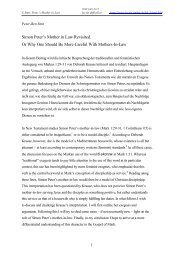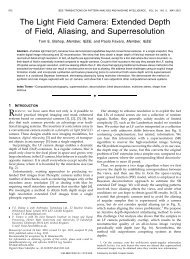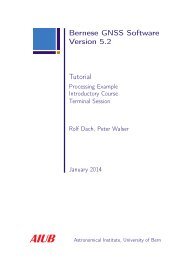Minimal Models of Adapted Neuronal Response to In Vivo–Like ...
Minimal Models of Adapted Neuronal Response to In Vivo–Like ...
Minimal Models of Adapted Neuronal Response to In Vivo–Like ...
Create successful ePaper yourself
Turn your PDF publications into a flip-book with our unique Google optimized e-Paper software.
Adapting Rate <strong>Models</strong> 2105<br />
the self-consistent equation<br />
f = (m − αf, s), (2.2)<br />
which requires only the knowledge <strong>of</strong> the response function (the actual<br />
dynamics leading <strong>to</strong> equation 2.2 is dealt with in more detail in section 3). It<br />
is easy <strong>to</strong> prove that the adapted firing rate, f α , is always a stable fixed point<br />
<strong>of</strong> equation 2.2: the condition for stability reads ≡ ∂ f (m − αf, s)| fα < 1;<br />
for equation 2.2, one has =−α∂ m (m − αf, s)| fα < 0, as α>0 and is an<br />
increasing function <strong>of</strong> m.<br />
2.1 Examples. We checked the rate model, equation 2.2, against full simulations<br />
for several versions <strong>of</strong> IF neurons. <strong>In</strong> each case, the rate function in<br />
the presence <strong>of</strong> noise, , is known.<br />
2.1.1 Leaky <strong>In</strong>tegrate-and-Fire Neuron. The leaky integrate-and-fire (LIF)<br />
neuron is the best-known and most widely used <strong>of</strong> all IF neurons (see section<br />
A.1 for details <strong>of</strong> the model). Its response function in the presence <strong>of</strong><br />
noise has been known for a long time; it reads<br />
[<br />
LIF (m, s) = τ r + τ<br />
∫ Cθ−mτ<br />
σ √ τ<br />
CVr−mτ<br />
σ √ τ<br />
√ πe<br />
x 2 (1 + erf(x))dx<br />
] −1<br />
(2.3)<br />
(Siegert, 1951; Ricciardi, 1977; Amit & Tsodyks, 1991). V r and τ r are the reset<br />
potential and the absolute refrac<strong>to</strong>ry period after spike emission, which is<br />
said <strong>to</strong> occur when the membrane potential hits a fixed threshold θ; τ is<br />
the membrane time constant; C is the membrane capacitance; and erf(x) =<br />
(2/ √ π) ∫ x<br />
0 dte−t2 is the error function. m and σ = √ 2τ ′ s are the average<br />
current and the amplitude <strong>of</strong> the fluctuations, with s in units <strong>of</strong> current and<br />
τ ′ a time constant <strong>to</strong> preserve units (set equal <strong>to</strong> 1 ms throughout).<br />
The equivalence between the rate model and the full simulation for different<br />
values <strong>of</strong> the noise is shown in Figure 1A. We report also the lower<br />
bound for the time constant (around τ N ∼ 80 ms) for which the result<br />
holds (see Figure 1B). For irregular spike trains the agreement is remarkable<br />
also at very low frequencies, where the condition that the average ISI be<br />
smaller than τ N is violated. This may be explained by the fact that although<br />
> τ N , the ISI distribution is skewed <strong>to</strong>wards smaller values, and<br />
I ahp ∼−αf is still a good approximation.<br />
2.1.2 Quadratic <strong>In</strong>tegrate-and-Fire Neuron. The quadratic integrate-andfire<br />
(QIF) neuron—see section A.2—is related <strong>to</strong> a canonical model <strong>of</strong> type I<br />
membrane (see, e.g., Ermentrout & Kopell, 1986; Ermentrout, 1996). As such,<br />
it is expected <strong>to</strong> reproduce the firing behavior <strong>of</strong> any type I neuron close <strong>to</strong>
















